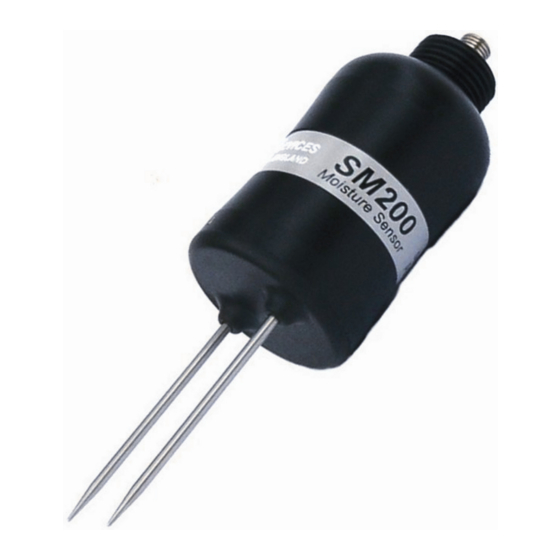
Table of Contents
Advertisement
Quick Links
Advertisement
Table of Contents

Summary of Contents for Delta-T Devices SM200
- Page 1 SM200 Soil Moisture Sensor Quick Start Guide Version 1.3 Delta-T Devices Ltd...
- Page 2 SM200 overview Data Loggers Cables Installation © 2005 Delta-T Devices Ltd Page 2...
- Page 3 SM200 horizontally. If you feel strong resistance when inserting the SM200, you have probably hit a stone. Stop, and re-insert at a new location. Installing at depth Auger a 45mm diameter hole. ~10° to vertical is recommended.
- Page 4 Store Press to save or Esc to discard the reading. Remove the SM200 from the soil and move to a new location... If you have saved data, connect your HH2 to a PC and run HH2Read to retrieve the readings.
- Page 5 Data Loggers 2 SM200s can be connected to each GP1 - the SM200 should be connected as a single-ended, powered sensor. These details illustrate connections for Channel1: SM200 wiring Colour GP1 terminal Power V+ CH1 (PWR) Signal White CH1 (+)
- Page 6 For configuration details see the DL2e User Manual. Other data loggers The SM200 should be connected as a single-ended, powered sensor. Configure the logger input as a voltage sensor, approximately 0 to 1.0 volts corresponding to ~0 to 60% water content – see next section.
- Page 7 Convert SM200 voltages to soil moisture readings Note: The SM200 output is automatically converted to soil moisture when using an HH2 meter or Delta-T data loggers. Example = 0.294 volts Take a reading with the SM200 either Convert the reading to √ε using the polynomial or √ε...
- Page 8 Percentages quoted as %vol are % volumetric water content. Care and Safety The rods of the SM200 are sharp in order to ease insertion. Care must be taken and handling precautions followed. Avoid touching the rods or exposing them to other sources of static damage.




Need help?
Do you have a question about the SM200 and is the answer not in the manual?
Questions and answers